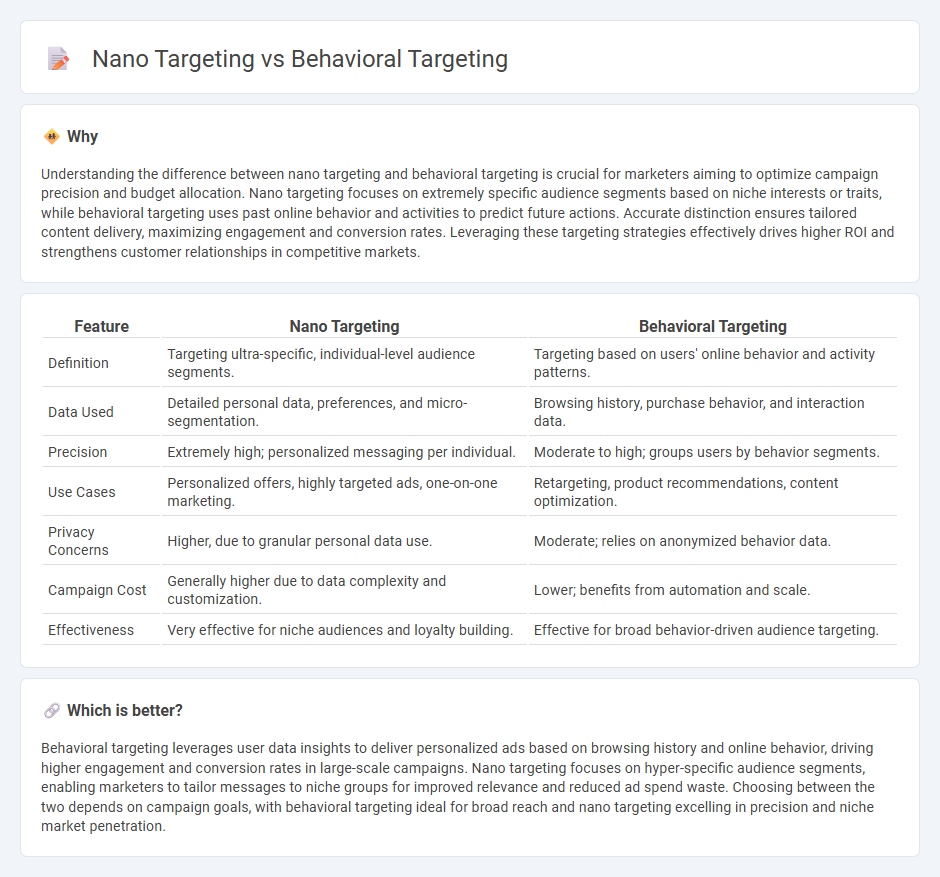
Nano targeting focuses on highly specific audience segments based on granular data points such as individual preferences, location, and real-time behavior to deliver personalized marketing messages. Behavioral targeting relies on analyzing users' past online actions, such as browsing history and purchase behavior, to predict and influence future engagement. Explore the advantages and applications of nano targeting versus behavioral targeting to enhance your marketing strategy.
Why it is important
Understanding the difference between nano targeting and behavioral targeting is crucial for marketers aiming to optimize campaign precision and budget allocation. Nano targeting focuses on extremely specific audience segments based on niche interests or traits, while behavioral targeting uses past online behavior and activities to predict future actions. Accurate distinction ensures tailored content delivery, maximizing engagement and conversion rates. Leveraging these targeting strategies effectively drives higher ROI and strengthens customer relationships in competitive markets.
Comparison Table
| Feature | Nano Targeting | Behavioral Targeting |
|---|---|---|
| Definition | Targeting ultra-specific, individual-level audience segments. | Targeting based on users' online behavior and activity patterns. |
| Data Used | Detailed personal data, preferences, and micro-segmentation. | Browsing history, purchase behavior, and interaction data. |
| Precision | Extremely high; personalized messaging per individual. | Moderate to high; groups users by behavior segments. |
| Use Cases | Personalized offers, highly targeted ads, one-on-one marketing. | Retargeting, product recommendations, content optimization. |
| Privacy Concerns | Higher, due to granular personal data use. | Moderate; relies on anonymized behavior data. |
| Campaign Cost | Generally higher due to data complexity and customization. | Lower; benefits from automation and scale. |
| Effectiveness | Very effective for niche audiences and loyalty building. | Effective for broad behavior-driven audience targeting. |
Which is better?
Behavioral targeting leverages user data insights to deliver personalized ads based on browsing history and online behavior, driving higher engagement and conversion rates in large-scale campaigns. Nano targeting focuses on hyper-specific audience segments, enabling marketers to tailor messages to niche groups for improved relevance and reduced ad spend waste. Choosing between the two depends on campaign goals, with behavioral targeting ideal for broad reach and nano targeting excelling in precision and niche market penetration.
Connection
Nano targeting and behavioral targeting are connected through their focus on hyper-personalization based on user data. Nano targeting segments audiences into extremely narrow groups using detailed behavioral insights, such as browsing history, purchase behavior, and online interactions. This precise targeting increases the relevance of marketing messages, enhancing engagement and conversion rates.
Key Terms
Behavioral Targeting:
Behavioral targeting utilizes data from users' past online activities, such as browsing history, search queries, and purchase behavior, to deliver personalized advertisements tailored to individual preferences. This method enhances ad relevance and improves conversion rates by predicting consumer interests based on behavioral patterns. Explore behavioral targeting strategies to boost your marketing efficiency and customer engagement.
User Behavior Data
Behavioral targeting analyzes user behavior patterns such as browsing history, purchase history, and search queries to deliver personalized ads that increase engagement and conversion rates. Nano targeting refines this approach by leveraging hyper-specific data points, including micro-moments and real-time interactions, enabling ultra-precise audience segmentation. Explore how these strategies can optimize ad performance and maximize ROI through advanced user behavior data insights.
Segmentation
Behavioral targeting segments audiences based on past actions, such as browsing history, purchase behavior, and interaction patterns to deliver personalized ads. Nano targeting refines this approach by leveraging hyper-specific data points, including micro-segmentation and real-time contextual cues, enabling ultra-precise audience profiles. Explore more to understand how these advanced segmentation techniques enhance marketing efficiency.
Source and External Links
What is Behavioral Targeting? | Examples, Benefits & How ... - Behavioral targeting is a digital advertising strategy that collects users' online activity data, segments them by shared behaviors, and delivers personalized ads to increase campaign impact and relevance.
What Is Behavioral Targeting? How It Works (in 4 Steps) - Behavioral targeting uses data collected from user browsing, app usage, and interactions to segment audiences into detailed profiles, enabling advertisers to serve highly relevant ads.
What is behavioral targeting and why it's important - This marketing strategy tracks and analyzes user behavior to deliver personalized content and ads, improving engagement, campaign efficiency, and customer loyalty by focusing on relevant user interests.
 dowidth.com
dowidth.com